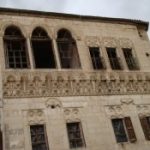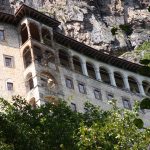A village called Onion Population: 350
The little village of Soğanlı is probably best known for the hand-made dolls that are on sale all over Cappadocia. However, if you’re in the area and looking for an alternative to the popular Ihlara Gorge you could head for Soğanlı, which lies midway between Derinkuyu and Yeşilhisar in a rare public-transport desert. Consequently it used to receive far fewer visitors than Ilhara despite offering much the same mix of spectacular scenery and ancient rock-cut churches. However, the introduction of hot-air ballooning to the village has seen the number of visitors soar.
The approach road to Soğanlı is rather offputting since the modern village (dating back only to 1997) consists of a cluster of ugly prefabricated bungalows dominated by an outsize modern mosque, its domes covered with what looks like silver paper.
Once past all that, however, the scenery soon perks up as you arrive in a typically Cappadocian village of crumbling stone houses huddled beneath soaring rock plateaus.
Around the valleys
Old Soğanlı consists of three valleys with multiple rock-cut churches but most people head straight off towards the Karabaş Kilise (Church of the Black Head), which boasts fine frescoes from the 11th to 13th centuries.
A little further on is the Yılanlı Kilise (the Church with the Snake), part of a monastic complex carved out of the rock. Inside, the church is still unrestored, its frescoes blackened with soot and hard to decipher. Once your eyes get used to the dark you should be able to identify a Christ Pantocrater on the ceiling immediately inside the door. You will also be able to pick out a sea of haloed saints on the walls. You will search in vain, however, for any sign of a snake. Instead, on the west wall of the chapel to the north of the entrance you will be able to make out the fading remains of a St George and the Dragon, the coils of the dragon presumably leading villagers to believe they were looking at a picture of a snake. The frescoes in this church may only date from the 15th century which would make them some of the newest in Cappadocia.
Even though the churches are supposedly protected most visitors are very disappointed to see graffiti just a few years old etched into these irreplaceable medieval paintings. Interestingly, some of the graffiti date back to 1899 and 1910, at which point they seem to acquire a historic interest all of their own.
From the Yılanlı Kilise paths head off in two different directions, but if you walk straight ahead and cross the small stream you will soon be heading uphill towards the 14th-century Kubbeli Kilise (Church with a Dome) that marks Soğanlı out from the rest of Cappadocia. Here, uniquely, the top of a natural rock formation has been shaped into a dome in imitation, perhaps, of an Armenian church. Inside the two-storied building you will find more frescoes as well as the rock-cut altars and columns so typical of the area. (There are similar churches at Kilistra, near Konya, and Ayazini, near Afyon.)
With more time on your hands there are plenty of other churches to explore – indeed it is thought that Soğanlı may originally have had almost 150 churches.
Other possibilities include the 11th-century Tokalı Kilise (Buckle Church) which is up steep steps on the right-hand side of the road as you come into the village.
Well worth tracking down, too, is the Geyikli Kilise (Church with a Deer) which is past the village square and retains much of its monastic complex, including an impressive refectory table and benches cut clean out of the rock (and only rediscovered in the 1990s), as well as a faded 11th-century fresco of St Eustace and a deer.
Soğanlı is also well known for the pigeon-houses that liberally dot the craggy rockfaces. In other parts of Cappadocia these are often decorated with elaborate paintings but here they are surrounded with whitewash which, the locals claim, helped the pigeons pick the entrance holes out from the surrounding rock. The result is to make it look as if Soğanlı’s dramatic canyon walls are one huge outdoor shooting range.
Söganlı dolls Soğanlı is also home to the Soğanlı doll, a cloth doll that was originally made wearing a white wedding dress but now appears in a range of şalvars and clutching a water pitcher, baby or skein of wool. The dolls seem to have come into being more than 40 years ago when a tourist watched a woman make a simple doll for her daughter by wrapping material around a twig. Nowadays the finest dolls boast conical head-dresses and long plaits that end in pompoms as well as curiously blank expressions painted on cloth stretched over the severed rims of old soft-drink bottles.
Like Barbie, the Soğanlı doll has spawned a male counterpart, although he’s nothing like as popular.
Local women line up to sell the dolls in the main square. They hold a patent for their manufacture although these days the dolls can be found on sale elsewhere in Cappadocia (and on the Internet) too.
Sleeping
Emek Pension Dormitory-style cave rooms on half-board basis. Tel: 0352-653 1029
Transport info
To get to Soğanlı by public transport from the tourist hotspots such as Göreme and Ürgüp you first have to get a bus to Kayseri, then another to Yeşilhisar. That still leaves you 15km away. The Emek Pension will pick customers up from Yeşilhisar but for most people without a car it makes more sense to sign up for a tour from Göreme, Uçhisar or Ürgüp.
With a car, it’s worth knowing that the drive south to Soğanlı from Ürgüp and Mustafapaşa takes you past several under-visited sites, including Damsa Lake, the Keslik Monastery and the beautiful Selçuk medrese-turned-library at Taşkınpaşa.

